Restructuring the Coupling Coordination Mechanism of the Economy–Energy–Environment (3E) System Under the Dual Carbon Emissions Control Policy—An Exploration Based on the “Triangular Trinity” Theoretical Framework
Abstract
1. Introduction
2. Materials and Methods
2.1. Construction of the “Triangular Trinity” Theoretical Framework
2.2. Construction of the 3E System (Intermediate Triangle) Indicator Framework
2.3. Calculation of Coupling Coordination Degree
2.4. Decoupling Assessment of the Economy from Energy and Carbon Emissions
2.5. Scenario Design
2.6. Monte Carlo Model Construction Based on the 3E System
- (1)
- System state equations
- (2)
- Stochastic parameter generation
2.7. Data Sources and Processing
3. Results
3.1. Evolution of 3E System Coupling Coordination Development
- (1)
- Historical evolution patterns of 3E system coordination
- (2)
- Development trends under different policy scenarios
3.2. Differential Analysis of Energy Conservation and Emission Reduction Under Policy Scenarios
- (1)
- Energy consumption trajectories
- (2)
- Carbon emission dynamics
- (3)
- Decoupling evolution analysis
4. Discussion
4.1. Dual Carbon Emissions Control Policy’s Resolution of the Energy Trilemma (Internal Triangle)
4.2. Reconstruction Logic of Dual Carbon Emissions Control Policy for 3E System (Central Triangle) Coupling Relationships
- (1)
- Low-carbon restructuring of energy system
- (2)
- Structural reshaping of the economic system
- (3)
- Synergistic improvement of the environmental system
4.3. Analysis of the Supporting Role of Dual Carbon Emissions Control Policy on the External Triangle
4.4. Negative Impacts of the Dual Carbon Emissions Control Policy Within the “Triangular Trinity” Framework
5. Conclusions
Author Contributions
Funding
Data Availability Statement
Conflicts of Interest
Appendix A
| Interval Value of Degree of Coupling Coordination | Coordination Level | Degree of Coupling Coordination |
|---|---|---|
| [0.0~0.1) | 1 | Extreme disorder |
| [0.1~0.2) | 2 | Barely coordinated |
| [0.2~0.3) | 3 | Moderate disorder |
| [0.3~0.4) | 4 | Mild disorder |
| [0.4~0.5) | 5 | Verging on disorder |
| [0.5~0.6) | 6 | Barely coordinated |
| [0.6~0.7) | 7 | Primary coordination |
| [0.7~0.8) | 8 | Intermediate coordination |
| [0.8~0.9) | 9 | Good coordination |
| [0.9~1.0] | 10 | High-quality coordination |
| Subsystem | Indicator | Weight (%) | ||
|---|---|---|---|---|
| BAU Scenario | EC Scenario | CC Scenario | ||
| Economic subsystem (3) | Gross GDP (+) Proportion of tertiary industry (+) Per Capita Gross Domestic Product (+) | 37.97 28.07 33.95 | 37.7 28.73 33.58 | 37.23 29.51 33.26 |
| Energy subsystem (3) | Total energy consumption (−) Share of non-fossil energy (+) Self-sufficiency rate of energy (+) | 40.26 31.85 27.89 | 43.94 29.94 26.13 | 29.14 36.97 33.89 |
| Environment subsystem (3) | Carbon emissions (−) Forest carbon storage (+) PM2.5 (−) | 45.14 33.03 21.83 | 61.64 22.9 15.46 | 66.51 19.8 13.69 |
| Decoupling Elasticity Value (Dt) | ΔC/C | ΔGDP/GDP | Decoupling State | Description |
|---|---|---|---|---|
| Dt < 0 | <0 | >0 | Strong Decoupling | Economic growth with decreasing carbon emissions |
| 0 ≤ Dt < 0.8 | >0 | >0 | Weak Decoupling | Economic growth rate is higher than carbon emission growth rate |
| 0.8 ≤ Dt ≤ 1.2 | >0 | >0 | Expansive Coupling | Economic growth rate is relatively synchronized with carbon emission growth rate |
| Dt > 1.2 | >0 | >0 | Expansive Negative Decoupling | Economic growth rate is lower than carbon emission growth rate |
| Dt < 0 | >0 | <0 | Strong Negative Decoupling | Economic decline with increasing carbon emissions |
| 0 ≤ Dt < 0.8 | <0 | <0 | Weak Negative Decoupling | Economic decline rate is greater than carbon emission decline rate |
| 0.8 ≤ Dt ≤ 1.2 | <0 | <0 | Recessive Coupling | Economic decline rate is relatively synchronized with carbon emission decline rate |
| Dt > 1.2 | <0 | <0 | Recessive Decoupling | Economic decline rate is lower than carbon emission decline rate |
References
- State Council. Notice on the Division of Work for Implementing the Main Objectives and Tasks of the “Outline of the Eleventh Five-Year Plan for National Economic and Social Development of the People’s Republic of China”. Gaz. State Counc. People’s Repub. China 2006, 29, 30–36. [Google Scholar]
- Xinhua News Agency. Central Economic Work Conference Held, Xi Jinping and Li Keqiang Deliver Important Speeches. Available online: https://www.gov.cn/xinwen/2021-12/10/content_5659796.htm (accessed on 20 May 2025).
- State Council of the People’s Republic of China. Outline of the 14th Five-Year Plan for National Economic and Social Development and the Long-Range Objectives Through the Year 2035. 2021. Available online: https://www.gov.cn/xinwen/2021-03/13/content_5592681.htm (accessed on 1 April 2025).
- State Council of the People’s Republic of China; National Development and Reform Commission; National Energy Administration. Notice on Printing and Distributing the “14th Five-Year Plan for Modern Energy System”: Development and Reform Energy [2022] No.210. 2022. Available online: https://www.gov.cn/zhengce/zhengceku/2022-03/23/content_5680759.htm (accessed on 29 March 2025).
- General Office of the State Council. Notice on Printing and Distributing the “Work Plan for Accelerating the Construction of the Carbon Emission Dual Control System”: Guobanfa [2024] No. 39. 2024. Available online: https://www.gov.cn/zhengce/zhengceku/202408/content_6966080.htm (accessed on 20 March 2025).
- Aldy, J.E.; Stavins, R.N. The Promise and Problems of Pricing Carbon: Theory and Experience. J. Environ. Dev. 2012, 21, 152–184. [Google Scholar] [CrossRef]
- Gawel, E.; Strunz, S.; Lehmann, P. A public choice view on the climate and energy policy mix in the EU—How do the emissions trading scheme and support for renewable energies interact? Energy Policy 2014, 64, 175–182. [Google Scholar] [CrossRef]
- Dai, H.C.; Xie, Y.; Liu, J.Y.; Masui, T. Aligning renewable energy targets with carbon emissions trading to achieve China’s INDCs: A general equilibrium assessment. Renew. Sustain. Energy Rev. 2018, 82, 4121–4131. [Google Scholar] [CrossRef]
- Pahle, M.; Quemin, S.; Osorio, S.; Guenther, C.; Pietzcker, R. The emerging endgame: The EU ETS on the road towards climate neutrality. Rresource Energy Econ. 2025, 81, 101476. [Google Scholar] [CrossRef]
- Liao, L.P.; Kong, S.N.; Du, M.Z. The effect of clean heating policy on individual health: Evidence from China. China Econ. Rev. 2025, 89, 102309. [Google Scholar] [CrossRef]
- Zhou, S.; Qi, T.Y.; Zhao, X.G. Realization of global representative concentration pathways emission scenarios and its regional impacts. Syst. Eng.-Theory Pract. 2017, 37, 2091–2101. [Google Scholar]
- Wang, B.B.; Jotzo, F.; Qi, S.Z. Expost cap adjustment for China’s ETS: An applicable indexation rule, simulating the Hubei ETS, and implications for a national scheme. Clim. Policy 2018, 18, 258–273. [Google Scholar] [CrossRef]
- Tian, H.D.; Wang, W.; Luo, B.H.; Peng, Q.S. Internal logic and realization path of transformation from “double control” of energy consumption to “double control” of carbon emission under the “double carbon” strategy. Energy Res. Manag. 2023, 15, 16–22. [Google Scholar]
- Xie, D.; Gao, Y.J.; Lu, X.B.; Liu, T.Y.; Zhao, L.; Zhao, Y. Implementation path study of the transition from energy consumption “dual control” to carbon emission “dual control”. Compr. Smart Energy 2022, 44, 73–80. [Google Scholar]
- Xuan, X.W. From “dual control” of energy consumption to “dual control” of carbon: Challenges and countermeasures. Urban Environ. Stud. 2022, 3, 42–55. [Google Scholar]
- Jang, C.H.; Yan, Z.H.; Wang, M. From dual control of energy consumption to dual control of carbon emissions under the constraints of carbon peaking and carbon neutrality goals: Regulatory tools, effect simulation and policy evaluation. China’s Ind. Econ. 2024, 11, 5–23. [Google Scholar]
- Tang, L.; Wang, P.; Ren, S.Y. From dual control of energy consumption to dual control of carbon: A comparative study of policies from multiple perspectives. Sci. Technol. Eng. 2024, 24, 11019–11029. [Google Scholar]
- Tang, F.; Dai, H.C.; Zhang, N.; Wu, Y.; Xue, M.M.; Chen, R. Effect analysis and promotion path design for transformation from energy consumption “dual control” to carbon “dual control”. Electr. Power 2023, 56, 255–261. [Google Scholar]
- Yang, F. Some thoughts on the transition from dual control of energy consumption to dual control of carbon emissions in Inner mongolia. Environ. Dev. 2023, 35, 18–22. [Google Scholar]
- Li, C.L.; Chang, X.Q.; Lu, H. Analysis and forecast of the shift from double control of energy consumption to double control of carbon emissions in Xinjiang. Power Gener. Technol. 2024, 45, 1114–1120. [Google Scholar]
- An, K.X.; Liu, M.K.; Fan, S.T.; Wang, C. Impact of transition from the energy consumption “dual control” to the carbon “dual control”: A CGE-based case study of Anhui. China Environ. Sci. 2024, 44, 1795–1804. [Google Scholar]
- Li, Z.C.; Pan, J.R.; Zhong, L. Research on promoting the shift from dual control of energy consumption to dual control of carbon emissions and striving to achieve peak carbon dioxide emissions and carbon neutrality: A case study of Jiangxi. Prices Mon. 2025, pp. 1–13. Available online: https://link.cnki.net/urlid/36.1006.F.20250522.1103.008 (accessed on 29 March 2025).
- Wang, C.; Ye, J.H.; Zhang, T.Y.; Huang, W. Research on the coal reduction path in Zhejiang Province under the background of transforming “Amount and Intensity Control of Energy Consumption” to “Amount and Intensity Control of Carbon Emission”. Environ. Pollut. Control. 2023, 45, 1307–1311. [Google Scholar]
- Wu, L.P. Considerations on Shanghai taking the lead in promoting the transition from “dual energy consumption control” to “dual carbon emissions control”. Shanghai Energy Conserv. 2023, 5, 546–552. [Google Scholar]
- Chang, W.; Lu, L.F.; Cao, D.Y. Analysis of development status and suggestions on response paths for the automotive industry under carbon emission dual control requirements. Automob. Parts 2024, 24, 24–28. [Google Scholar]
- Sun, W.J.; Zhang, S.J.; Men, X.J. Impact and countermeasures of the shift from dual control of energy consumption to dual control of carbon emissions on the oil and gas industry. Oil Gas New Energy 2024, 36, 34–40. [Google Scholar]
- Xu, H. Enterprise adaptation strategy under policy from dual control of energy consumption to dual control of carbon emission. Energy Energy Conserv. 2024, 4, 68–71. [Google Scholar]
- Hu, M.Y.; Gao, H.W.; Liao, J.; Liu, J.P.; Jiang, Q. Research on response strategies for petrochemical enterprises under the trend of “dual carbon emissions control” policy. Green Pet. Petrochem. 2023, 8, 10–14. [Google Scholar]
- Guangdong Provincial People’s Government. Notice of Guangdong Provincial People’s Government on Printing and Distributing the Implementation Plan for Carbon Peaking in Guangdong Province (Yuefu [2022] No. 56). 2022. Available online: http://www.gd.gov.cn/zwgk/gongbao/2023/4/content/post_4091315.html (accessed on 21 March 2025).
- Guangdong Provincial Committee of the Communist Party of China; Guangdong Provincial People’s Government. Implementation Opinions on Fully, Accurately and Comprehensively Implementing the New Development Concept to Promote Carbon Peaking and Carbon Neutrality Work. 2022. Available online: https://www.eesia.cn/contents/113/1701.html (accessed on 20 March 2025).
- Guangdong Provincial Development and Reform Commission. Notice on Further Strengthening the Energy Security for High-Quality Development in the Province (Yuefa Gai Neng Yuan Han [2023] No.491. 2023. Available online: http://drc.gd.gov.cn/ywtz/content/post_4169964.html (accessed on 20 March 2025).
- Cen, H.; Wang, W.; Chen, L.; Hao, W.; Guan, Z.; Lu, J.; Cai, G. Multi-Scenario Research on the Coupled and Coordinated Development of the Economic–Energy–Environmental (3E) System under the Reconstruction of the Power System—New Exploration Based on the “Dual Triangle” Theory. Energies 2024, 17, 3468. [Google Scholar] [CrossRef]
- Zhang, S.F.; Hu, T.T.; Li, J.B.; Cheng, C.; Song, M.L.; Xu, B.; Tomas, B. The effects of energy price, technology, and disaster shocks on China’s energy-environment-economy system. J. Clean. Prod. 2019, 207, 204–213. [Google Scholar] [CrossRef]
- Zhang, X.G.; Zhang, M.Y.; Zhang, H.; Jiang, Z.G.; Liu, C.H.; Cai, W. A review on energy, environment and economic assessment in remanufacturing based on life cycle assessment method. J. Clean. Prod. 2020, 255, 120160. [Google Scholar] [CrossRef]
- Lu, G.; Xu, S.Z.; Wang, P. Strategic Thinking of the Path for Electric Power Carbon Peak and Carbon Neutrality on Basis of Energy-Economy-Environment Relations. Pet. Sci. Technol. Forum 2020, 1, 57–62. [Google Scholar]
- Yang, L.; Sun, Z.C. The Development of western new type urbanization level evaluation based on entropy method. Econ. Probl. 2015, 3, 115–119. [Google Scholar]
- Zhao, A.W.; Li, D. Empirical analysis of the decoupling relationship between carbon emissions and economic growth in China. J. Technol. Econ. 2013, 32, 106–111. [Google Scholar]
- Guangdong Provincial Bureau of Statistics. Guangdong Statistical Yearbook 2024. 2025. Available online: http://stats.gd.gov.cn/gdtjnj/content/post_4626161.html (accessed on 15 March 2025).
- People’s Government of Guangdong Province. Implementation Plan of Guangdong Province for Energy Conservation and Emissions Reduction During the 14th Five-Year Plan Period (Yuefu [2022] No. 68). 2022. Available online: https://www.gd.gov.cn/zwgk/jhgh/content/post_4013726.html (accessed on 21 March 2025).
- People’s Government of Guangdong Province. Outline of the Construction Plan for a Beautiful Guangdong (2024–2035) (Yuefu [2024] No.231). 2024. Available online: https://www.gd.gov.cn/zwgk/jhgh/content/post_4608410.html (accessed on 20 March 2025).
- People’s Government of Guangdong Province. Action Plan for Energy Conservation and Carbon Emission Reduction from 2024 to 2025 (Yuefu [2024] No. 80). 2024. Available online: https://www.gd.gov.cn/zwgk/gongbao/2024/29/content/post_4638030.html (accessed on 21 March 2025).
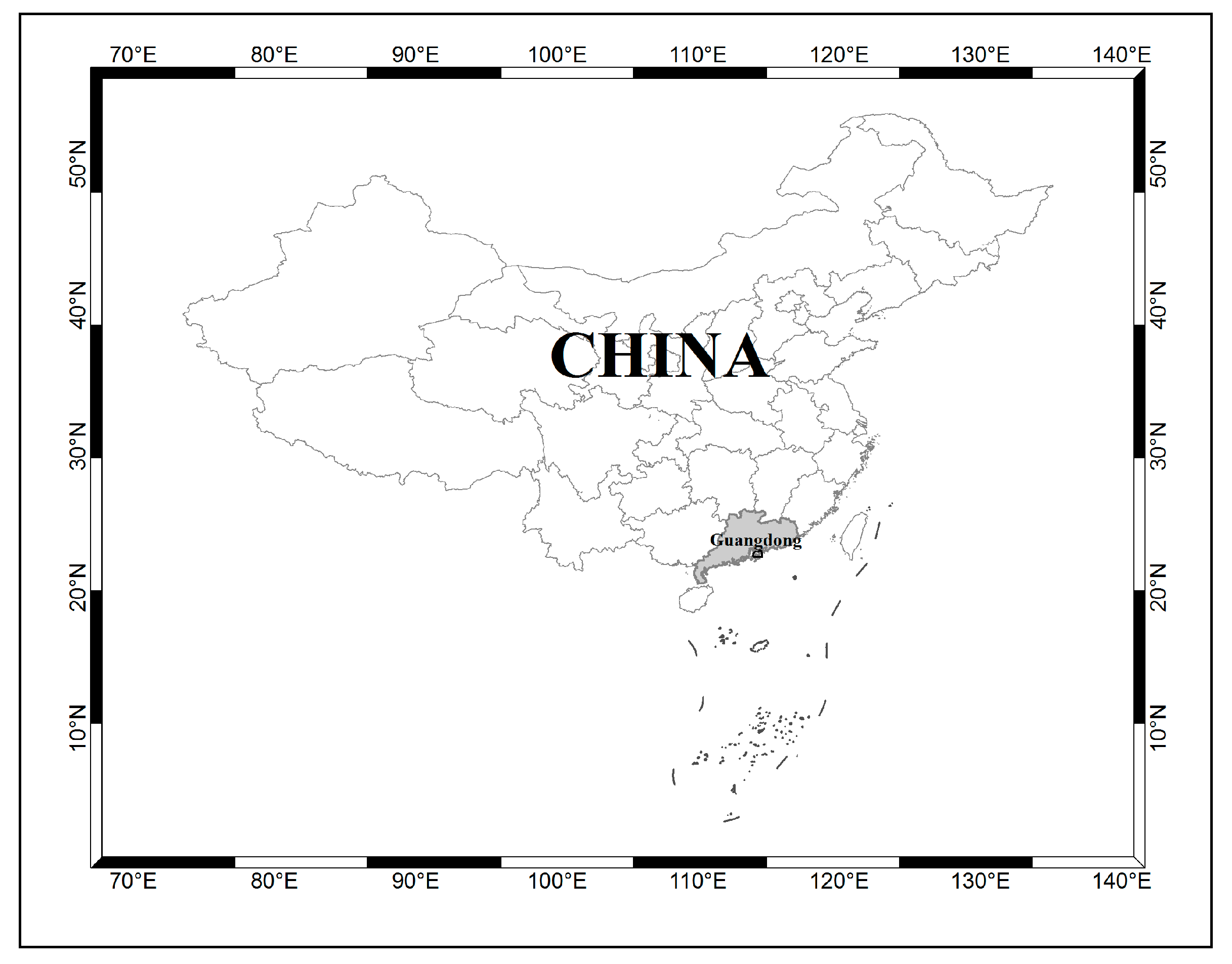

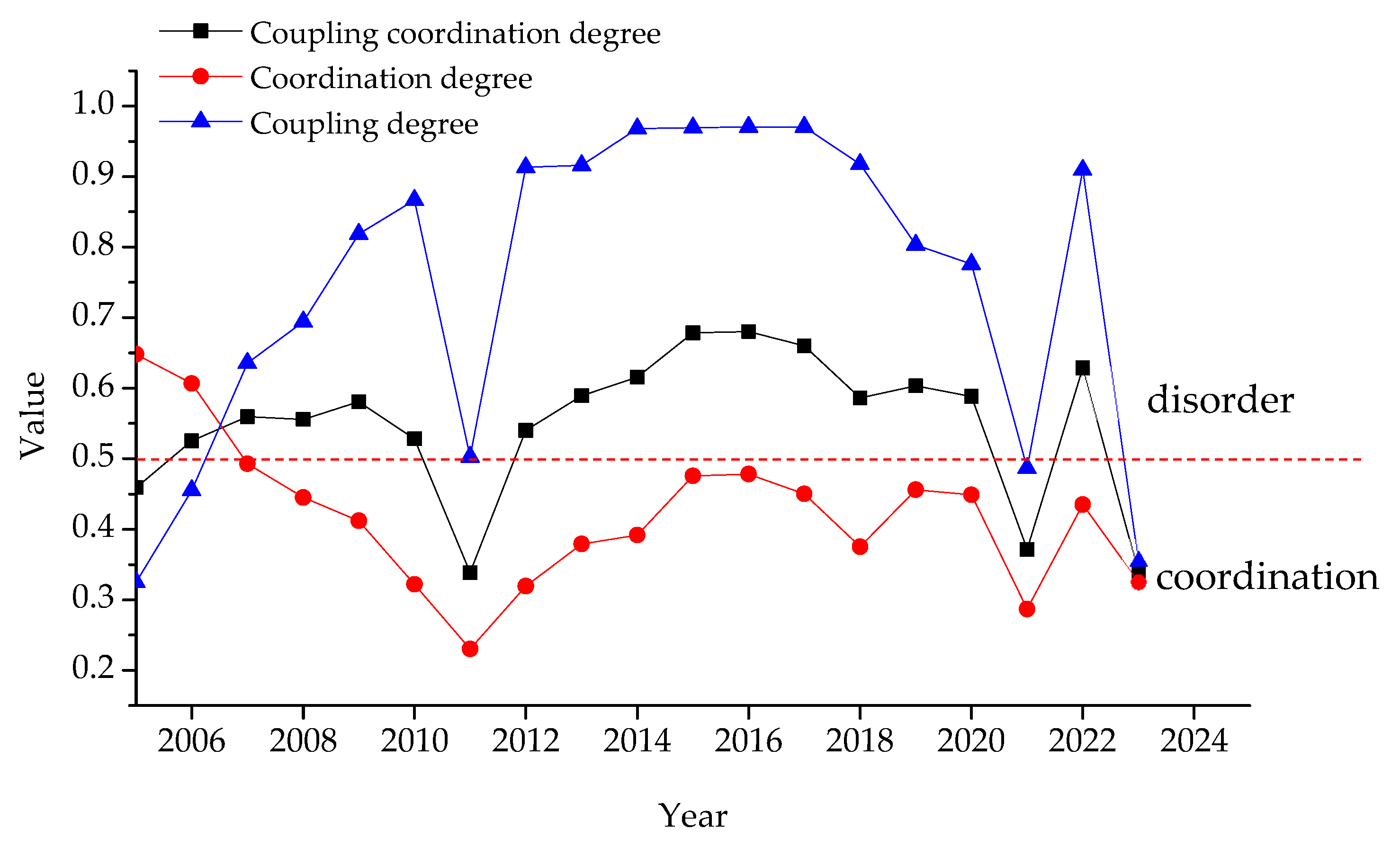


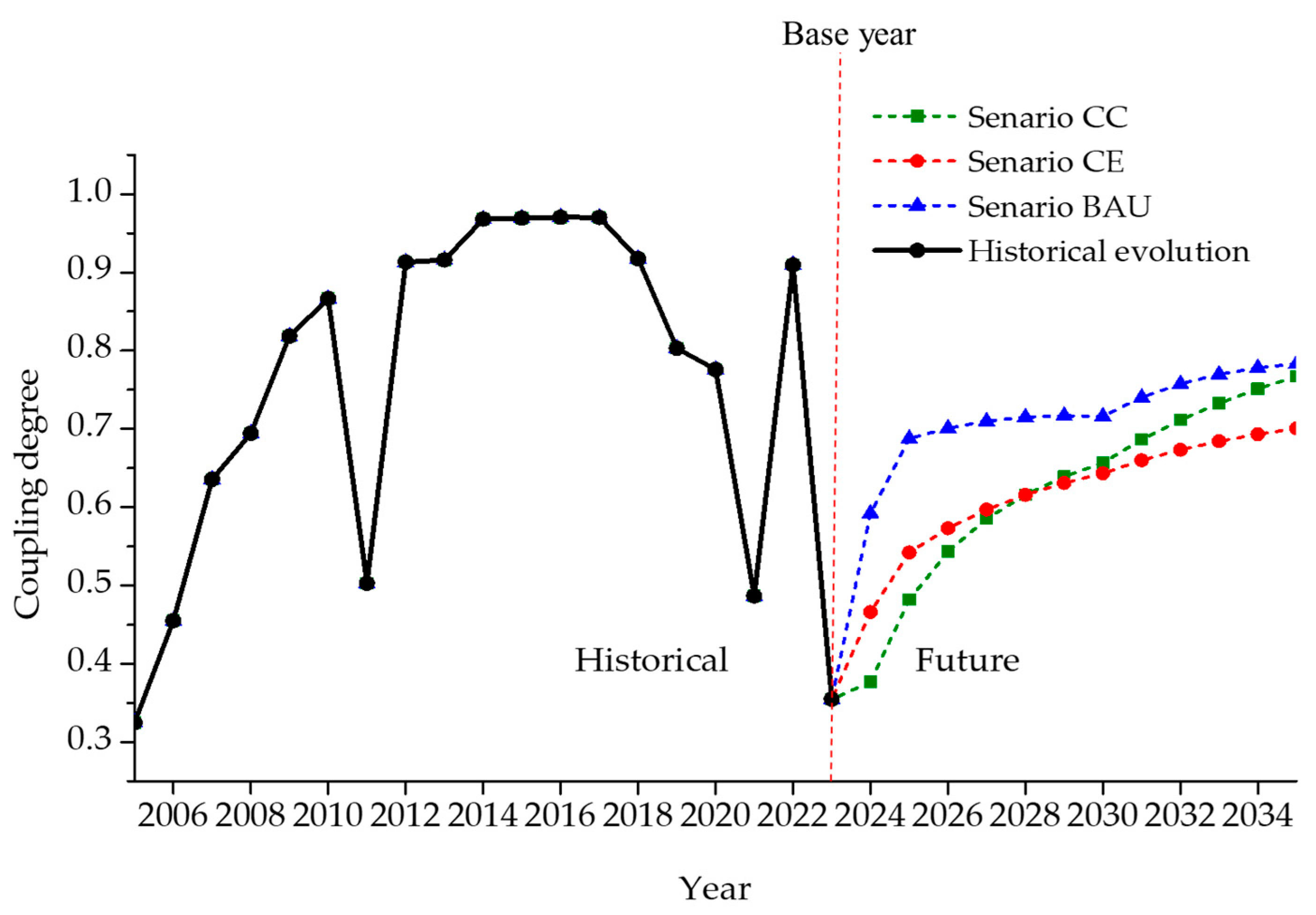

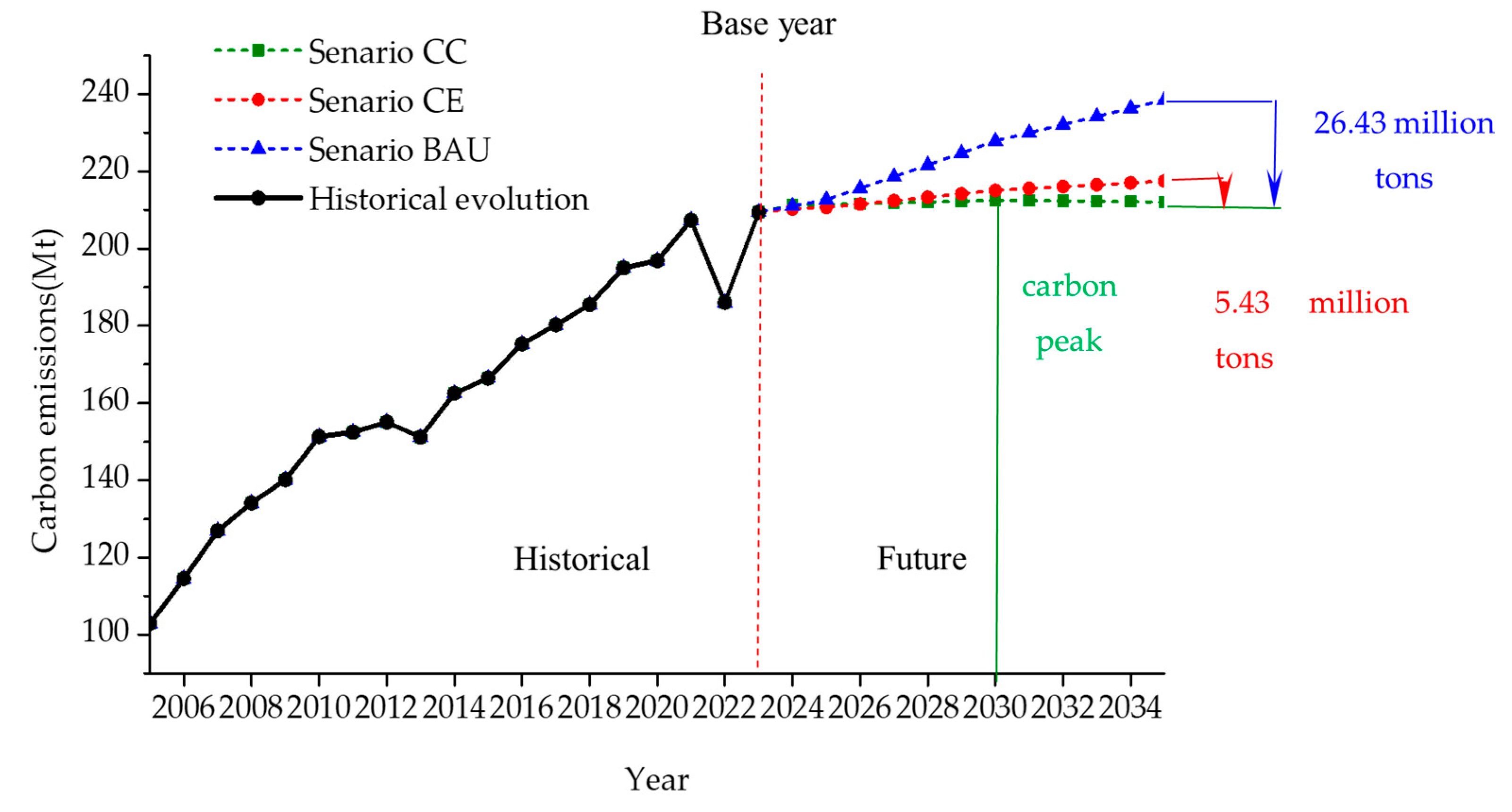



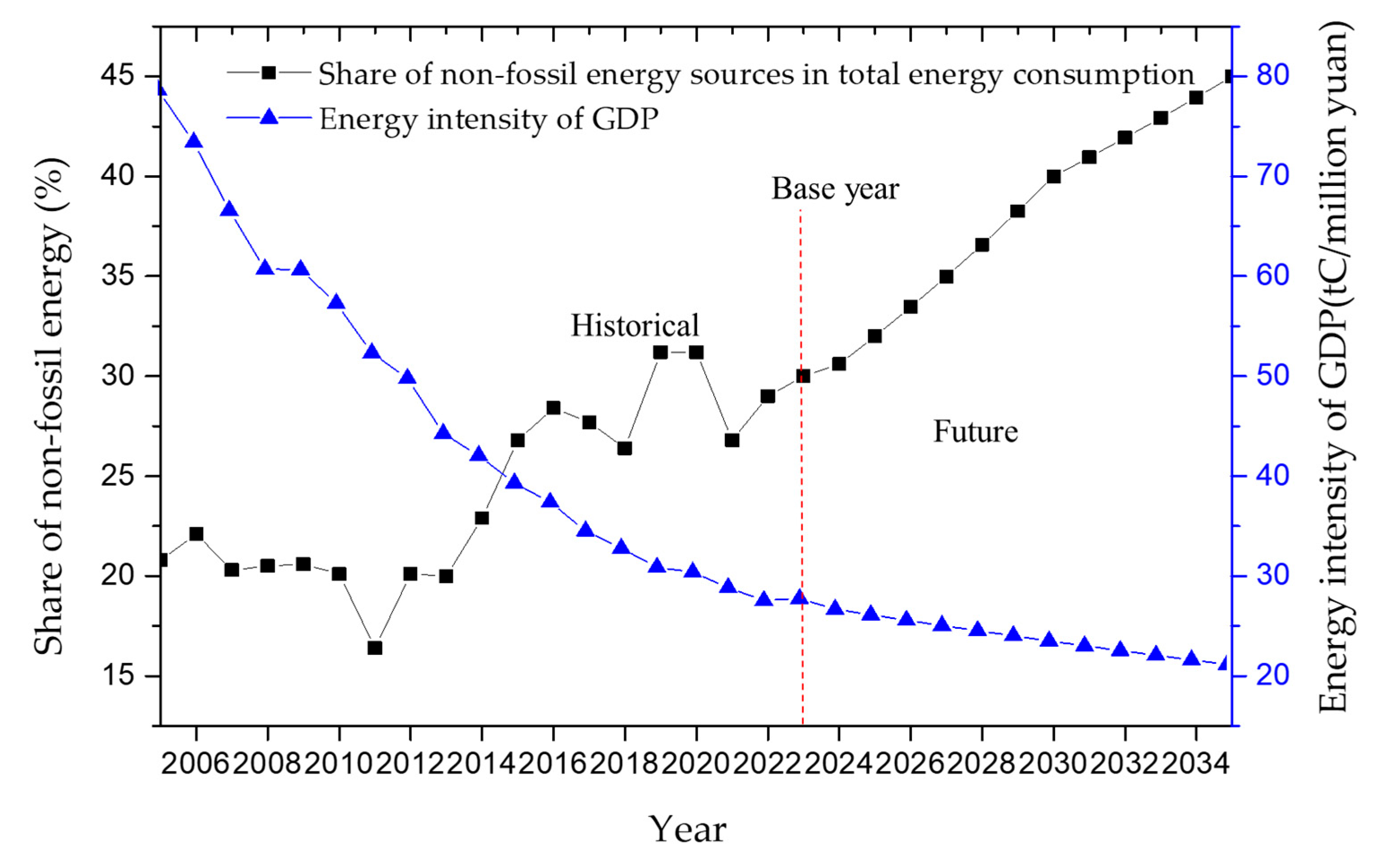
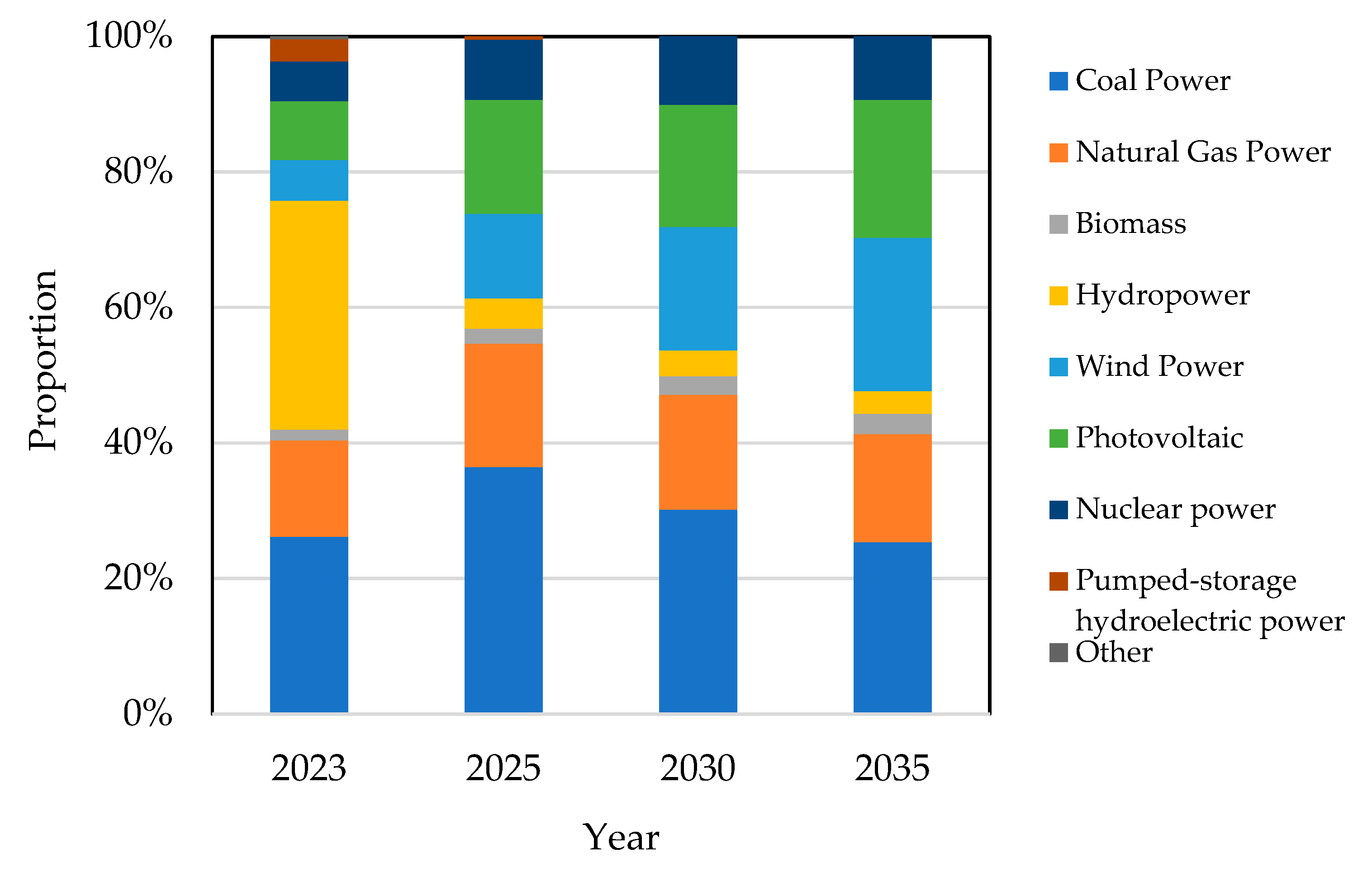
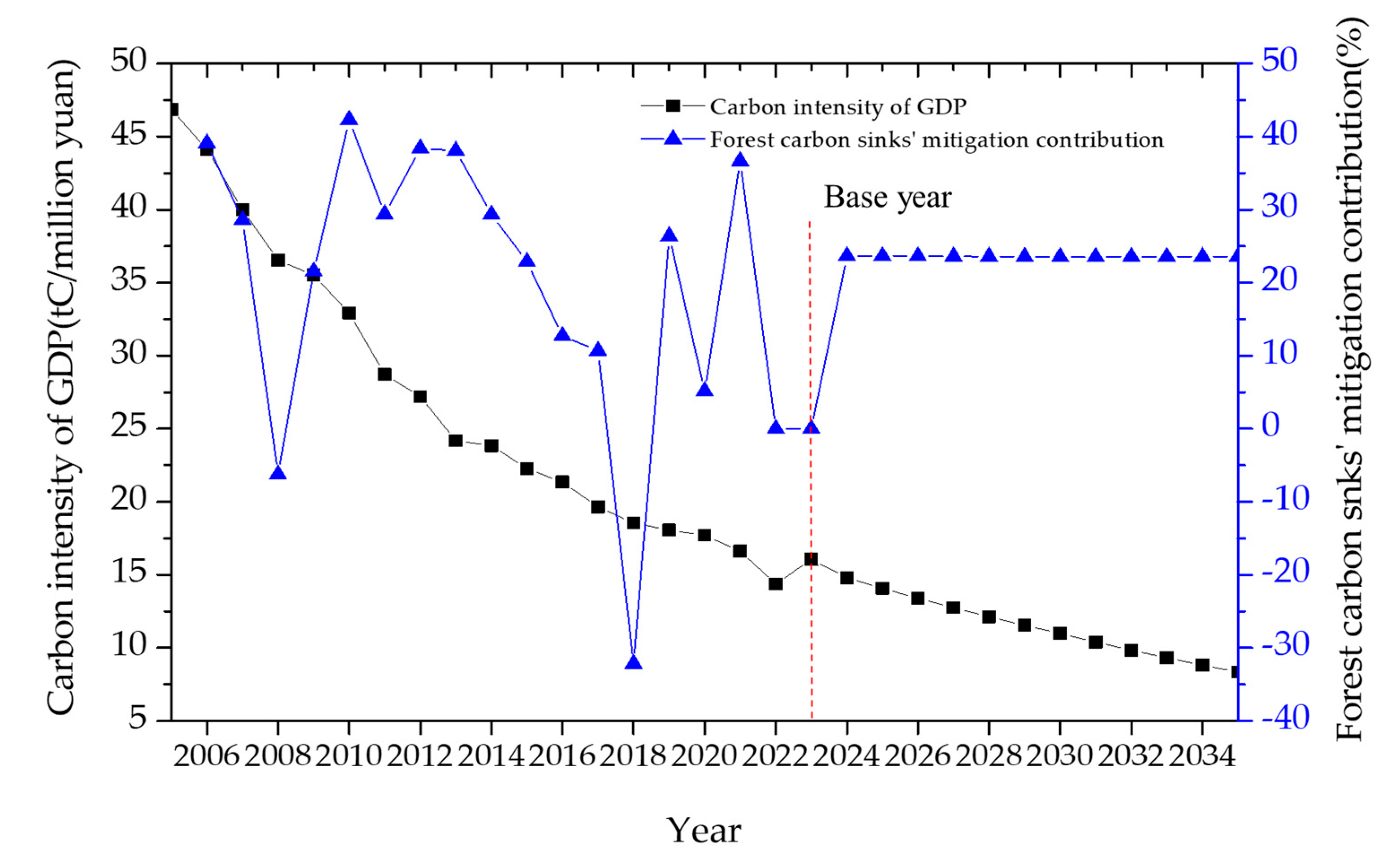
| Subsystem | 3E System Indicator |
|---|---|
| Economic subsystem (3) | Gross Domestic Product (GDP) (+) Proportion of tertiary industry (+) Per Capita Gross Domestic Product (+) |
| Energy subsystem (3) | Total energy consumption (−) Share of non-fossil energy (+) Self-sufficiency rate of energy (+) |
| Environment subsystem (3) | Carbon emissions (−) |
| Forest carbon storage (+) PM2.5 (−) |
| Scenarios | Scenario Description | Parameter Setting |
|---|---|---|
| Business-as-Usual (BAU) | Continuation of existing policies with maintained dual energy consumption control mechanisms. |
|
| Enhanced dual energy consumption control (EC) | Building upon the BAU scenario, this intensifies dual energy consumption control targets. |
|
| Dual carbon emissions control (CC) | Comprehensive implementation of the dual control of carbon emissions (total volume and intensity). |
|
Disclaimer/Publisher’s Note: The statements, opinions and data contained in all publications are solely those of the individual author(s) and contributor(s) and not of MDPI and/or the editor(s). MDPI and/or the editor(s) disclaim responsibility for any injury to people or property resulting from any ideas, methods, instructions or products referred to in the content. |
© 2025 by the authors. Licensee MDPI, Basel, Switzerland. This article is an open access article distributed under the terms and conditions of the Creative Commons Attribution (CC BY) license (https://creativecommons.org/licenses/by/4.0/).
Share and Cite
Xu, Y.; Wang, W.; Yan, X.; Cai, G.; Chen, L.; Cen, H.; Lin, Z. Restructuring the Coupling Coordination Mechanism of the Economy–Energy–Environment (3E) System Under the Dual Carbon Emissions Control Policy—An Exploration Based on the “Triangular Trinity” Theoretical Framework. Energies 2025, 18, 3735. https://doi.org/10.3390/en18143735
Xu Y, Wang W, Yan X, Cai G, Chen L, Cen H, Lin Z. Restructuring the Coupling Coordination Mechanism of the Economy–Energy–Environment (3E) System Under the Dual Carbon Emissions Control Policy—An Exploration Based on the “Triangular Trinity” Theoretical Framework. Energies. 2025; 18(14):3735. https://doi.org/10.3390/en18143735
Chicago/Turabian StyleXu, Yuan, Wenxiu Wang, Xuwen Yan, Guotian Cai, Liping Chen, Haifeng Cen, and Zihan Lin. 2025. "Restructuring the Coupling Coordination Mechanism of the Economy–Energy–Environment (3E) System Under the Dual Carbon Emissions Control Policy—An Exploration Based on the “Triangular Trinity” Theoretical Framework" Energies 18, no. 14: 3735. https://doi.org/10.3390/en18143735
APA StyleXu, Y., Wang, W., Yan, X., Cai, G., Chen, L., Cen, H., & Lin, Z. (2025). Restructuring the Coupling Coordination Mechanism of the Economy–Energy–Environment (3E) System Under the Dual Carbon Emissions Control Policy—An Exploration Based on the “Triangular Trinity” Theoretical Framework. Energies, 18(14), 3735. https://doi.org/10.3390/en18143735





